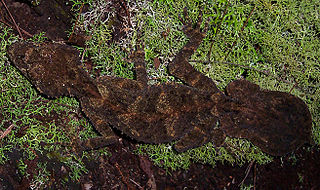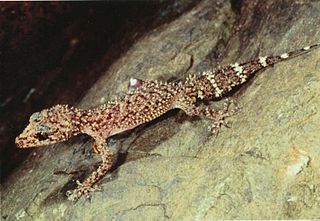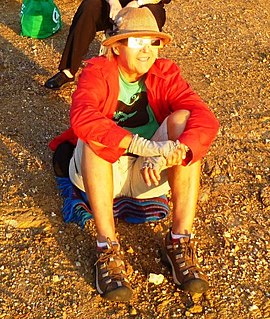
Uroplatus is a genus of geckos, commonly referred to as leaf-tail geckos or flat-tailed geckos, which are endemic to Madagascar and its coastal islands, such as Nosy Be. They are nocturnal, insectivorous lizards found exclusively in primary and secondary forest.

Phyllurus is a small genus of Australian leaf-tailed geckos. Rarely seen outside their native habitat, they are notable for their highly effective camouflage which is in part aided by the spiny tubercles that cover every body part.

Saltuarius is a genus of larger Australian geckos, known collectively as leaf-tailed geckos. The genus was created in 1993 to accommodate some former members of the genus Phyllurus. These geckos appear very similar to the Uroplatus geckos native to Madagascar. However, this is a convergent evolution.

Underwoodisaurus milii is a species of gecko, a lizard in the family Carphodactylidae. The species is commonly known as the thick-tailed or barking gecko, referring to its distinctive plump tail and sharp, barking defensive call. The genus is also often called thick-tailed geckos as a group, along with the species Uvidicolus sphyrurus.

The broad-tailed gecko, southern leaf-tailed gecko, or Sydney leaf-tailed gecko is a common gecko of the family Carphodactylidae found in the Sydney Basin. The species uses its mottled colour to camouflage against bark or rock, and if threatened can drop its large fleshy tail as a decoy. The tail is also useful for fat storage. This species of gecko is available in captivity as a pet, they are a nocturnal ambush hunter, relying on camouflage and patience to catch prey. Primary prey items include large nocturnal invertebrates such as spiders, cockroaches and beetles.

Champion's leaf-tailed gecko or the Koumala leaf-tailed gecko is a species of gecko, a lizard in the family Carphodactylidae. The species is endemic to Australia.
Hoburogekko is an extinct genus of gecko that includes a single species, Hoburogekko suchanovi, from the Early Cretaceous of Mongolia. It is known from two fossil specimens, one preserving the front part of the skull and the other preserving part of the lower jaw. Hoburogekko is one of four known Mesozoic geckos or gecko-like lizards, the others being Cretaceogekko from the Early Cretaceous of Burma, AMNH FR21444, an undescribed specimen from a slightly older deposit in Mongolia, and Gobekko from the Late Cretaceous of Mongolia. Hoburogekko is the third oldest known gecko behind AMNH FR21444 and Cretaceogekko.
Southern leaf-tailed gecko is a common name for several Australian lizards and may refer to:

The northern leaf-tailed gecko is a species of the genus Saltuarius, the Australian leaf-tailed geckos.

Jeanette Adelaide Covacevich (1945–2015) was a herpetologist in Queensland, Australia. As a senior curator of vertebrates at the Queensland Museum, she discovered and studied many reptiles and frogs in Queensland. Covacevich is most famous for describing the Inland Taipan snake, the world's most venomous land snake. In addition, she described over thirty new species and genera including the Cape York striped blind snake, the Nangura spinosa, and the Phyllurus caudiannulatus.
Phyllurus amnicola, also known as the Mount Elliot leaf-tailed gecko, is a species of geckos found in Australia. It is endemic to Mount Elliot in Bowling Green Bay National Park in northeastern Queensland.
Phyllurus caudiannulatus, also known as the Bulburin leaf-tailed gecko or ringed thin-tail gecko is a gecko found in Australia. It is endemic to the Bulburin State Forest in the Dawes Range and Many Peaks Range in southeastern Queensland.
Phyllurus gulbaru, the Gulbaru leaf-tailed gecko, is a species of geckos found in Australia. It is endemic to the extreme southern end of the Paluma Range in Queensland.
Phyllurus isis, also known commonly as the Mount Blackwood leaf-tailed gecko and the Mount Jukes broad-tailed gecko, is a species of gecko, a lizard in the family Carphodactylidae. The species is endemic to Mount Blackwood and Mount Jukes in mideastern Queensland, Australia.
Phyllurus kabikabi, also known as the Oakview leaf-tailed gecko is a gecko found in Australia. It is endemic to Oakview National Park in Queensland.

Phyllurus nepthys, also known commonly as the Eungella leaf-tailed gecko, is a species of lizard in the family Carphodactylidae. The species is endemic to Australia.
Phyllurus ossa, also known as the Mackay Coast leaf-tailed gecko is a gecko found in Australia. It is endemic to Mount Ossa National Park and Dryander National Park in mideastern Queensland.

Saltuarius salebrosus, also known as the rough-throated leaf-tailed gecko or Central Queensland leaf-tailed gecko, is a gecko found in Australia. It is endemic to dry areas in mid-eastern and south-central Queensland.

Pygopodoidea is a gecko superfamily and the only taxon in the gekkotan subclade Pygopodomorpha. The clade includes three Australasian families: Diplodactylidae, Carphodactylidae, and Pygopodidae. Traditional gekkotan systematics had considered Diplodactylidae and Carphodactylidae as subfamilies of the family Gekkonidae, but recent molecular work have placed Pygopodidae within Gekkonidae making it paraphyletic. These analyses have shown support of Pygopodidae and Carphodactylidae being sister taxa, with Diplodactylidae occupying a basal position in Pygopodoidea.










